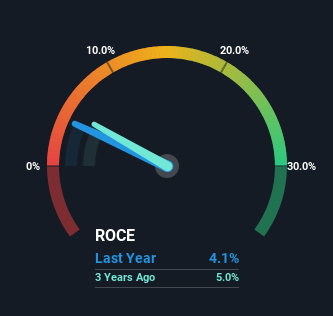- Malaysia
- /
- Electric Utilities
- /
- KLSE:TENAGA
The Returns At Tenaga Nasional Berhad (KLSE:TENAGA) Aren't Growing
If we want to find a potential multi-bagger, often there are underlying trends that can provide clues. Firstly, we'll want to see a proven return on capital employed (ROCE) that is increasing, and secondly, an expanding base of capital employed. Basically this means that a company has profitable initiatives that it can continue to reinvest in, which is a trait of a compounding machine. However, after briefly looking over the numbers, we don't think Tenaga Nasional Berhad (KLSE:TENAGA) has the makings of a multi-bagger going forward, but let's have a look at why that may be.
What Is Return On Capital Employed (ROCE)?
If you haven't worked with ROCE before, it measures the 'return' (pre-tax profit) a company generates from capital employed in its business. Analysts use this formula to calculate it for Tenaga Nasional Berhad:
Return on Capital Employed = Earnings Before Interest and Tax (EBIT) ÷ (Total Assets - Current Liabilities)
0.041 = RM7.0b ÷ (RM202b - RM31b) (Based on the trailing twelve months to September 2024).
So, Tenaga Nasional Berhad has an ROCE of 4.1%. In absolute terms, that's a low return but it's around the Electric Utilities industry average of 4.9%.
See our latest analysis for Tenaga Nasional Berhad

In the above chart we have measured Tenaga Nasional Berhad's prior ROCE against its prior performance, but the future is arguably more important. If you'd like to see what analysts are forecasting going forward, you should check out our free analyst report for Tenaga Nasional Berhad .
What The Trend Of ROCE Can Tell Us
There hasn't been much to report for Tenaga Nasional Berhad's returns and its level of capital employed because both metrics have been steady for the past five years. Businesses with these traits tend to be mature and steady operations because they're past the growth phase. So unless we see a substantial change at Tenaga Nasional Berhad in terms of ROCE and additional investments being made, we wouldn't hold our breath on it being a multi-bagger.
What We Can Learn From Tenaga Nasional Berhad's ROCE
We can conclude that in regards to Tenaga Nasional Berhad's returns on capital employed and the trends, there isn't much change to report on. Although the market must be expecting these trends to improve because the stock has gained 48% over the last five years. But if the trajectory of these underlying trends continue, we think the likelihood of it being a multi-bagger from here isn't high.
One more thing: We've identified 2 warning signs with Tenaga Nasional Berhad (at least 1 which is concerning) , and understanding these would certainly be useful.
While Tenaga Nasional Berhad isn't earning the highest return, check out this free list of companies that are earning high returns on equity with solid balance sheets.
Valuation is complex, but we're here to simplify it.
Discover if Tenaga Nasional Berhad might be undervalued or overvalued with our detailed analysis, featuring fair value estimates, potential risks, dividends, insider trades, and its financial condition.
Access Free AnalysisHave feedback on this article? Concerned about the content? Get in touch with us directly. Alternatively, email editorial-team (at) simplywallst.com.
This article by Simply Wall St is general in nature. We provide commentary based on historical data and analyst forecasts only using an unbiased methodology and our articles are not intended to be financial advice. It does not constitute a recommendation to buy or sell any stock, and does not take account of your objectives, or your financial situation. We aim to bring you long-term focused analysis driven by fundamental data. Note that our analysis may not factor in the latest price-sensitive company announcements or qualitative material. Simply Wall St has no position in any stocks mentioned.
About KLSE:TENAGA
Tenaga Nasional Berhad
Engages in the generation, transmission, distribution, and sale of electricity in Malaysia, the United Kingdom, Kuwait, the Republic of Ireland, Australia, and internationally.
Proven track record average dividend payer.
Market Insights
Community Narratives


Recently Updated Narratives


MINISO's fair value is projected at 26.69 with an anticipated PE ratio shift of 20x


Fiverr International will transform the freelance industry with AI-powered growth

Constellation Energy Dividends and Growth
Popular Narratives


MicroVision will explode future revenue by 380.37% with a vision towards success


NVDA: Expanding AI Demand Will Drive Major Data Center Investments Through 2026



